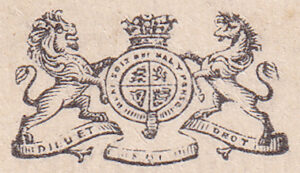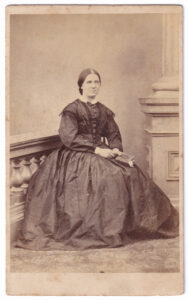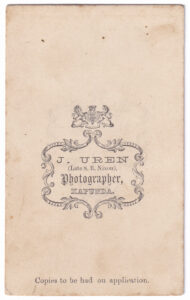[Editor: This carte de visite, featuring a photograph of a woman with a book, is undated; however, it is believed to have been made in the late 19th century.]
[Front of carte de visite]
[Description: Photograph of a woman, sitting down, holding a book.]
[Reverse of carte de visite]
J. Uren
(Late S. E. Nixon),
Photographer,
Kapunda.
Copies to be had on application.
[Description: The manufacturer’s information is headed by the British royal coat of arms, with the motto of the Order of the Garter, “Honi soit qui mal y pense”, on a circular stylised garter, and the motto of the British monarch, “Dieu et mon droit”, underneath a lion (symbol of England) and a unicorn (symbol of Scotland).]
Source:
Original document
Editor’s notes:
Dimensions (approximate): 63 mm. (width), 102 mm. (height).
 The British royal coat of arms, depicted on the reverse side of the carte de visite, is given here in higher definition, to enable a better look at the image.
The British royal coat of arms, depicted on the reverse side of the carte de visite, is given here in higher definition, to enable a better look at the image.
This carte de visite was printed on a thin cardboard mount, with square corners.
Dieu et mon droit = (French) “God and my right” (the phrase is used as the motto of the monarch of the United Kingdom)
See: 1) “Coats of Arms”, The Royal Household
2) “Dieu et mon droit”, Wikipedia
Honi soit qui mal y pense = an Anglo-Norman phrase, which has been translated as “shamed be whoever thinks ill of it”, “shame on anyone who thinks evil of it”, “shame on him who thinks this evil”, and “evil to him who evil thinks” (the phrase is used as the motto of the Order of the Garter)
See: 1) “Coats of Arms”, The Royal Household
2) “The Order of the Garter”, The Royal Household
3) Camille Chevalier-Karfis, “Origins of the expression ‘Honi Soit Qui Mal Y Pense’”, ThoughtCo. (updated 7 August 2019)
4) “Honi soit qui mal y pense”, Wikipedia
5) “honi soit qui mal y pense”, Wiktionary


Leave a Reply